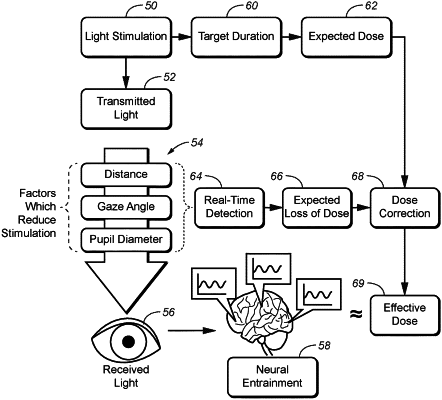| CPC A61M 21/02 (2013.01) [G16H 20/40 (2018.01); G16H 20/70 (2018.01); G16H 40/67 (2018.01); A61B 3/112 (2013.01); A61B 3/113 (2013.01); A61B 3/14 (2013.01); A61M 2021/0044 (2013.01); A61M 2205/3303 (2013.01); A61M 2205/583 (2013.01); G16H 10/60 (2018.01)] | 10 Claims |

|
1. An optical gamma brain stimulation system for a person comprising:
a processing system;
a visible-wavelength light source configured to strobe at a brain stimulation rate between 13-140 Hz, the light source being remote from the person so as not to be supported by the person; and
an eye-tracking device being remote from the person so as not to be supported by the person, the eye-tracking device being configured to detect an eye of the person and provide first data to the processing system as light from the light source is received into the eye of the person, the eye-tracking device comprising a camera and the processing system, wherein the eye-tracking device is configured to sense a gaze angle of the person with respect to the light source and an eye distance from the light source during a brain stimulation session, wherein the gaze angle and the eye distance are encoded in the first data,
wherein the processing system is configured to detect a deviation in the gaze angle and the eye distance in real-time, correlate the deviation with a reduction of therapeutically effective light dosage, and automatically extend a duration of the brain stimulation session based on the first data and detected deviation as a dose correction measure to provide a pre-programmed therapeutically effective target light dosage to the person irrespective of the gaze angle and the eye distance with respect to the light source deviating from a designated gaze angle and eye distance required to deliver the therapeutically effective target light dosage to the person.
|